The Plaka is the oldest section of Athens. Most of the streets
have been closed to
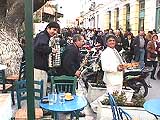 automobile traffic, though you should still
keep a watchful eye for a speeding motorcycle or delivery truck.
At one time it was the nightclub district, but most of these
closed down when the government out-lawed amplified music in the
area in the seventies in an effort to get rid of undesirables. The
strategy was very successful and it is now an area of restaurants,
tourist shops, and cafes. Though it is quite commercialized it is
still a neighbourhood and arguably the nicest neighbourhood in
central Athens. Most of the restaurants are typical tourist places
but the quality of food is not bad, you should have a few
enjoyable evenings and not be unpleasantly surprised by the bill.
automobile traffic, though you should still
keep a watchful eye for a speeding motorcycle or delivery truck.
At one time it was the nightclub district, but most of these
closed down when the government out-lawed amplified music in the
area in the seventies in an effort to get rid of undesirables. The
strategy was very successful and it is now an area of restaurants,
tourist shops, and cafes. Though it is quite commercialized it is
still a neighbourhood and arguably the nicest neighbourhood in
central Athens. Most of the restaurants are typical tourist places
but the quality of food is not bad, you should have a few
enjoyable evenings and not be unpleasantly surprised by the bill.
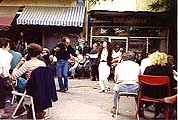 As for the tourist shops they are crammed full of stuff, some of
it junk but plenty of interesting items if you feel compelled to
bring back gifts to everyone you know. Most of the shops have
pretty much the same stuff for pretty much the same prices but
there are some that are more eclectic than others, selling
antiques, hand painted icons, woodcarvings and paintings. If you
wander around the Plaka you will find lots of other shops and even
the regular tourist shops have amazing postcards that you can send
home and make all your friends jealous.
As for the tourist shops they are crammed full of stuff, some of
it junk but plenty of interesting items if you feel compelled to
bring back gifts to everyone you know. Most of the shops have
pretty much the same stuff for pretty much the same prices but
there are some that are more eclectic than others, selling
antiques, hand painted icons, woodcarvings and paintings. If you
wander around the Plaka you will find lots of other shops and even
the regular tourist shops have amazing postcards that you can send
home and make all your friends jealous.
There are lots of jewellery stores. Most of them buy from factories and have the
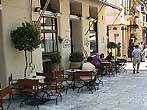 same stuff for about the same price. There are a
couple that are artist-owned which have hand-made original pieces
and also copies of ancient museum pieces. Gold jewellery in Greece
is inexpensive, not because the price of Gold is any cheaper but
because labour is. But generally the pieces that are hand-made by
the artists will have more value then the mass produced pieces of
the same weight.
same stuff for about the same price. There are a
couple that are artist-owned which have hand-made original pieces
and also copies of ancient museum pieces. Gold jewellery in Greece
is inexpensive, not because the price of Gold is any cheaper but
because labour is. But generally the pieces that are hand-made by
the artists will have more value then the mass produced pieces of
the same weight.
There are a few galleries like the Moraitis and there are several museums in the Plaka of special note the Children's Museum, the Music Museum, the Greek Folk Art Museum and the Jewish Museum, which is right at the entrance to the Plaka at Nikis and Kydatheneon streets.
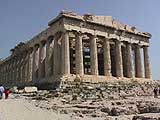 What would a visit to Greece be
without going to the Acropolis? You can take a tour or wander up
there yourself but during the summer, whatever you do, unless it
is overcast, go early in the day. It can get very hot up there and
gasping for breath can detract from your ability to marvel at the
greatest of all archaeological sites.
What would a visit to Greece be
without going to the Acropolis? You can take a tour or wander up
there yourself but during the summer, whatever you do, unless it
is overcast, go early in the day. It can get very hot up there and
gasping for breath can detract from your ability to marvel at the
greatest of all archaeological sites.
After climbing the steps you are at the entrance, or the Propylaea, which was completed in 432 just before the outbreak of the Peloponnesian wars, the main architect was Mnesicles, a colleague of Phidias. To your left is the Pinacotheca and a Hellenistic pedestal and on the right the tiny temple to Nike Athena or the Athena of Victory which commemorates the Athenians victory over the Persians. Supposedly this is the place where King Aegeus threw himself into the sea because he thought his son Theseus had been killed by the Minataur. But if this is the point he chose to jump into the Aegean then how good a king could he have been? The sea is miles away. If you are looking from the propylaea towards Piraeus on a clear day you can see ships waiting outside the port of Piraeus, the islands and the mountains of the Peleponesos beyond.
The Parthenon and the other main buildings on the Acropolis were built by Pericles
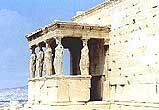 in the fifth century BC as a monument to the
cultural and political achievements of the inhabitants of Athens.
The term acropolis means upper city and many of the city states of
ancient Greece are built around an acropolis where the inhabitants
can go as a place of refuge in times of invasion. It's for this
reason that the most sacred buildings are usually on the
acropolis. It's the safest most secure place in town. As little as
150 years ago there were still dwellings on the Acropolis.
in the fifth century BC as a monument to the
cultural and political achievements of the inhabitants of Athens.
The term acropolis means upper city and many of the city states of
ancient Greece are built around an acropolis where the inhabitants
can go as a place of refuge in times of invasion. It's for this
reason that the most sacred buildings are usually on the
acropolis. It's the safest most secure place in town. As little as
150 years ago there were still dwellings on the Acropolis.
The best time to go up there is the spring when even this stone mountain is not immune to the proliferation of grass and wildflowers which seem to burst from every crack.
The Erecthion sits on the most sacred site of the Acropolis where Poseidon and Athena had their contest over who would be the Patron of the city. Poseidon thrust his trident into the rock and a spring burst forth, while Athena touched the ground with a spear and an olive tree grew. Athena was declared the victor and the great city of Athens was named for her while Poseidon was given a small village in Syros after it was discovered he had merely ruptured a water main, (not really). The building itself contains the porch of the maidens or Caryatids, which are now copies, four of which have been placed in the Acropolis museum.
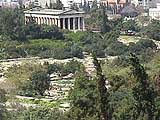 Even having seen a thousand photographs one is still not prepared
for the immensity of the Parthenon. The building was designed by
the architects Kallikrates and Iktinos as the home of the giant
statue of Athena. It took 15 years to build and was completed in
438 BC and is probably the most recognizable structure in the
world next to the golden arches of MacDonalds. From a temple it
became a church, a mosque and finally as a storage facility for
Turkish gunpowder. In 1687 the Venetians bombarded it from below.
A cannon ball hit the gun powder and blew it up.
Even having seen a thousand photographs one is still not prepared
for the immensity of the Parthenon. The building was designed by
the architects Kallikrates and Iktinos as the home of the giant
statue of Athena. It took 15 years to build and was completed in
438 BC and is probably the most recognizable structure in the
world next to the golden arches of MacDonalds. From a temple it
became a church, a mosque and finally as a storage facility for
Turkish gunpowder. In 1687 the Venetians bombarded it from below.
A cannon ball hit the gun powder and blew it up.
Below the Acropolis is the theatre of Herod Atticus built by the Romans in 161 AD and still used today for classical concerts, ballet, and performances of high cultural value. Further on is the Theatre of Dionysious the first stone theatre and home to Sophocles, Aeschylus, Euripides and Aristophanes. It was rebuilt around 342 BC by Lykourgos and then enlarged by the Romans to be used for gladiator fights.
Below the Acropolis is the rock of Areios Pagos. The steps are very slippery so be careful as you climb them, but once you do you won't want to come down (unless it is 100 degrees). You have a great view of the Agora, the Plaka, Monastiraki, Omonia and much of Athens. It's a great place to watch the sunset, or to come up at night with a bottle of wine and your true love, and watch the lights of the city.
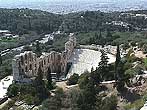 Afterwards, continue back around the Acropolis and down the hill
into the Ancient Agora below. Part of it is free and you can go
through it to get back to Adrianou Street, or you can pay the
entrance fee and walk the streets of ancient Athens.
Afterwards, continue back around the Acropolis and down the hill
into the Ancient Agora below. Part of it is free and you can go
through it to get back to Adrianou Street, or you can pay the
entrance fee and walk the streets of ancient Athens.
You may notice at the entrance to the Acropolis and the paths leading up to it the licensed guides, who for around 30 Euros or so, will give you a tour so that you may leave the area more informed then when you got here.
The Monastiraki flea market is the
place to be on Sunday's when it seems every
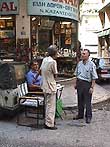 Athenian is here either buying or selling. You have to get here early because after
about 11am the crowd becomes impossible and if you want to take a
break there are few tables available at the many cafes and
restaurants in the area. You can wander around aimlessly or you
can find someone who knows the flea market who can show you around
if you are intent on buying something in particular.
Athenian is here either buying or selling. You have to get here early because after
about 11am the crowd becomes impossible and if you want to take a
break there are few tables available at the many cafes and
restaurants in the area. You can wander around aimlessly or you
can find someone who knows the flea market who can show you around
if you are intent on buying something in particular.
Much of the flea market is not really a flea market. It is a collection of small shops of which most of them are tourist shops with the same stuff you will find on Adrianou street in the Plaka. These are open normal shop hours and you can come here anytime. But weekends and Sunday in particular is when it is like a third-world flea market with people selling anything from antiques to what you might call useless junk and it goes on forever, beyond Monastiraki and into Thission and Psiri.
Getting to the flea market is easy. If you are coming from
Syntagma you will be walking down Metropolitan street, past the
Cathedral and the square of shiny
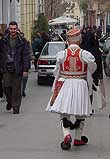 marble. There is a small
Byzantine church in the shadow of the cathedral that you should
take a look at called Agios Eleftherios. There are some cafes in
the square and this is where Pondrosou street begins. This section
of Pondrossou is the high end section of Monastiraki. If you are
coming from the Plaka, near the end of Adrianou street you will
come to a small square, every inch of which has been taken over by
fancy tourist restaurants and cafes. Hurry through it until you
come face to face with Hadrian's wall. You can't miss it. Turn
right and then take a left down tiny Pondrousou Street. (If you
need to ask directions remember Bonanza: The Ponderosa). You are
now in the tourist infested heart of the so-called Monastiraki
Flea-Market. But Keep walking to where Pondrossou becomes narrow
and the shops get a little smaller.
marble. There is a small
Byzantine church in the shadow of the cathedral that you should
take a look at called Agios Eleftherios. There are some cafes in
the square and this is where Pondrosou street begins. This section
of Pondrossou is the high end section of Monastiraki. If you are
coming from the Plaka, near the end of Adrianou street you will
come to a small square, every inch of which has been taken over by
fancy tourist restaurants and cafes. Hurry through it until you
come face to face with Hadrian's wall. You can't miss it. Turn
right and then take a left down tiny Pondrousou Street. (If you
need to ask directions remember Bonanza: The Ponderosa). You are
now in the tourist infested heart of the so-called Monastiraki
Flea-Market. But Keep walking to where Pondrossou becomes narrow
and the shops get a little smaller.
What to Buy? Anything that looks interesting. As noted before, Sunday is the best
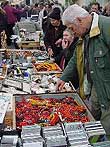 day to be here because you never know what you
will find. But on regular shopping days the tiny shops contain
everything from worry beads, furs, backgammon sets, toy evzone
soldiers, ancient Greek bottle openers and cigarette lighters,
Byzantine Icons, paintings, statues, postcards, high fashion such
as T-shirts, handbags with pictures of the Parthenon and so on.
day to be here because you never know what you
will find. But on regular shopping days the tiny shops contain
everything from worry beads, furs, backgammon sets, toy evzone
soldiers, ancient Greek bottle openers and cigarette lighters,
Byzantine Icons, paintings, statues, postcards, high fashion such
as T-shirts, handbags with pictures of the Parthenon and so on.
Overlooking Monastiraki square, (which is still pretty much of a construction site), and across the street from the metro station is the restored Turkish Mosque, now the traditional ceramics museum. Right next door are the large columns and ruins of the Roman Emperor Hadrian's Library and the Roman agora. This is the street where many of the street vendors are and if you go up and take a right on Adrianou the road runs parallel to the metro tracks and the ancient Agora with the Stoa of Attalos museum. Here you will find several cafes, ouzeries a couple restaurants and lots of people selling stuff right on the street, and plenty of interesting people.
National Archaeological Museum
The National Archaeological Museum ranks among the top ten museums
in the world. It's impressive collection is housed in a beautiful
neoclassic building near the juncture of Alexandras Avenue on
Patission Avenue. There is a gift shop, and a cafe in the
sculpture garden.
The museum is a five minute walk from Victoria Station and 10 min. from Omonia.
The Trolley #'s 1,2,3,5,6,7,8,9,11,13, and 15 all stop there.
Hours: Tue-Fri: 8am-7pm. Mon:12:30pm-7pm. Sat, Sun &
Holidays:8:30am-3pm
(there is an internet cafe right next door where you can send e-mail home)
The Benaki Museum
Agia Sofias and Kouvari. Tel 210 3671000
After at least 5 years of renovations it is finally open again.
Starting at the bottom floor with the ancient stuff and going up
through the various periods of Greek history. On the third floor
are the heroes of the Greek Revolution and the birth of the modern
state of Hellas. Just walk up Vass Sophias from Syntagma with the
National Gardens on your right. Then you reach the end of the
Gardens look to your left and that is it.
Open Mon, Wed, Fri, Sat: 9 to 5. Thurs and Sun they close early.
Closed Tues.
The Goulandris Museum of Cycladic and Ancient Greek Art
4 Neofytou Douka St, Koloniki. Tel 210 7228321 or 210 7228323
This Outstanding collection of ancient Cycladic art is excellently curated.
Open daily except Sundays and Tuesdays from 10am to 4pm.
Kerameikos Museum
148 Ermou. Tel 210 3463552
The ancient cemetery of Athens at the bottom of Ermou past the
Monastiraki flea market has a nice little museum. The site itself
is off the beaten path. Lots of pottery and tombstones.
Tues-Sun: 8:30 to 3. Closed Monday
Museum of Greek Folk Art
17 Kydatheneon St Plaka. Tel 210 3231577
Embroideries, wood carvings, jewellery, and other traditional folk
art. The museums not-to-be-missed collection of ceramics is housed
in a beautifully renovated former mosque at 1 Areos Street on
Monastiriki Square.
Open daily except Mondays from 10am to 2pm.
Jewish Museum
39 Nikis street at Kydatheneon in the Plaka. Tel 210 3231577
Before the Nazi occupation and the decimation of Greece's Jewish
population, many of Greece's Jewish communities traced their roots
back to the Spanish Inquisition and before to Classical Greece.
Art and artifacts from Jewish communities through the ages, as
well as documentation of the Holocaust makes this museum a cultural treasure.
Opening hours: Daily 9.00-2.30, except Saturdays and Sundays 10.00-2.00
National Gallery
50 vas Konstandinou street (opposite the Hilton). Tel 210 7235937
The permanent collection of modern Greek painters and
international contemporary artists includes large-scale sculptures.
Open daily from 9am to 3pm. Sunday from 10am to 2pm. Closed Tuesday.
National Historical Museum
13 Stadiou street (in the old Parliament Building). Tel 210 3237617
This museum is perfect for those interested in the Greek War of
Independence and it's artifacts.
Open daily from 9am to 1:30pm. Closed Mondays.
Museum of Popular Musical Instruments
1-2 Diogenes St. Plaka. Tel 210 3250198
You can wander around listening to different instruments and
styles of music through headphones at each exhibit.
Open daily from 10am to 2pm. Wednesday from 12 to 6pm. Closed on
Mondays. Admission Free.
Byzantine Museum
22 Vasilissis Sofias Ave. Tel 210 7211027
A divine collection of Icons, Mosaics, Sculptures,
Bibles, Garments and more.
Open Tuesdays to Sunday 8:30am to 3pm.
War Museum
2 Rizari St. & Vass. Sofias Ave. (next to the Byzantine
Museum). Tel 210 7290543
War implements from ancient times to this century including
armour, swords, torpedo's, and fighter planes. Photographs of
various Greek campaigns and battles.
Open Tuesday to Saturday from 9am to 2pm. Sunday from 9:30am to
2pm. Closed Mondays.
Theatrical Museum
50 Acadamias st. Tel 210 3629430
Greek theatre History. Photographs, programs, masks, costumes, posters etc.
Open Monday to Friday from 9am to 2:30pm. Closed Saturday and Sunday.
Greek Historical Costume Museum
7 Dimokritou st, Kolonaki. Tel 210 3629513
Mon, Weds, Fri:10-1. Thurs: 5:30-8:30.
Frissiras Museum of Contemporary Greek and European Painting
3 & 7, Monis Asteriou str. (junction of Monis Asteriou and
Kidathinaion str, Plaka).
tel. no. 210 3234678, 210 3316027
Wednesday-Friday 11.00-19.00. Saturday-Sunday 10.00-15.00
The Museum is closed on Mondays and Tuesdays.
The Frissiras Museum of Contemporary Greek and European Painting
is the only museum of its kind in Greece. It houses a private
collection of contemporary paintings and drawings as well as
temporary exhibitions of Greek and European artists, in two fully
renovated neoclassical buildings of the 19th century.
There are others, including the Acropolis Museum which is on the Acropolis. Don't forget the Children's Museums on Kydatheneon street and Voulis streets. Especially if you have children. Also the Metro stations at Syntagma and the Acropolis have archaeological displays worth visiting. be aware that sometimes the hours change with the seasons. You can also find the hours in the Athens News.
